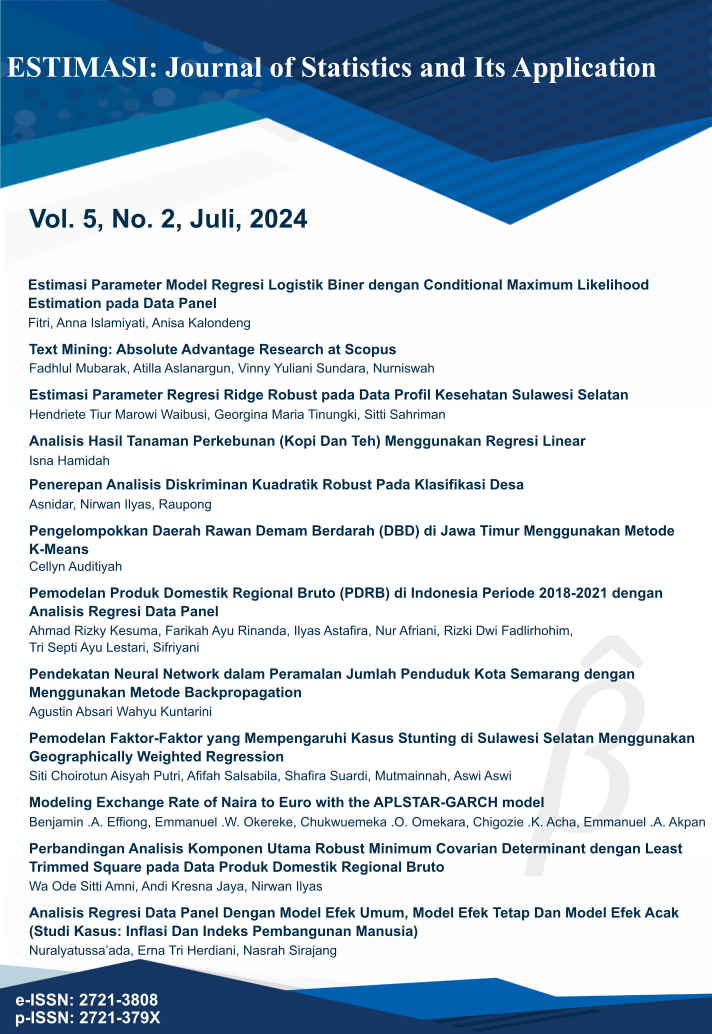Pemodelan Faktor-Faktor yang Mempengaruhi Kasus Stunting di Sulawesi Selatan Menggunakan Geographically Weighted Regression
DOI:
https://doi.org/10.20956/ejsa.v5i2.30142Keywords:
Stunting, Spatial, Geographically Weighted RegressionAbstract
One of the prevalent nutritional issues affecting toddlers worldwide is stunting. Several studies on stunting cases have been conducted in Indonesia. However, modeling using the Geographically Weighted Regression (GWR) method in South Sulawesi has not been carried out. This study aims to identify the variables that affect the incidence of stunting in each district in South Sulawesi based on spatial modeling using the GWR method. Data on the number of stunting cases, the pproportion of low-birth-weight infants, the percentage of under-five who are malnourished, the percentage of proper drinking water, and the percentage of poor people in South Sulawesi in 2020 were used. The results show that the GWR model has an value of 86.64%, which is higher than that of the global regression model. The factors that influence the percentage of stunting based on the GWR modeling results are the percentage of under-five who are malnourished and the percentage of proper drinking water. The findings of this study are anticipated to help the government address the issue of stunting in South Sulawesi. Early prevention may then be implemented.
References
Komalasari, K., Supriati, E., Sanjaya, & Ifayanti, H. Faktor-Faktor Penyebab Kejadian Stunting Pada Balita. Maj. Kesehat. Indones., 1(2), pp. 51–56, 2020, doi: 10.47679/makein.202010.
Kemenkes R. I. Hasil Riset Kesehatan Dasar Tahun 2018. Kementrian Kesehat. RI, 53(9), pp. 1689–1699, 2018.
Kemenkes RI, Profil Kesehatan Indonesia 2020. Indonesia, 2020. doi: 10.1524/itit.2006.48.1.6.
Dinas Kesehatan Sulawesi Selatan, Profil Kesehatan Provinsi Sulawesi Selatan 2021. Dinas Kesehat. Provinsi Sulawesi Selatan. Makassar: Dinas Kesehatan Provinsi Sulawesi Selatan, 2021.
Griffith, D. A., & Anselin, L. Spatial Econometrics: Methods and Models, 65(2). 1989. doi: 10.2307/143780.
Qiu, Q., Sung, J., Davis, W., & Tchernis, R. Using spatial factor analysis to measure human development. J. Dev. Econ., 132, 130–149, 2018, doi: https://doi.org/10.1016/j.jdeveco.2017.12.007.
Ma, Y., & Gopal, S. Geographicallyweighted regression models in estimating median home prices in towns of Massachusetts based on an urban sustainability framework. Sustain., 10(4), 2018, doi: 10.3390/su10041026.
Beal, T., Tumilowicz, A., Sutrisna, A., Izwardy, D., & Neufeld, L. M. A review of child stunting determinants in Indonesia. Matern. Child Nutr., 14(4), 1–10, 2018, doi: 10.1111/mcn.12617.
Aswi, A., Sukarna, S., & Nurhilaliyah. Pemetaan Risiko Relatif Kasus Stunting di Provinsi Sulawesi Selatan. Sainsmat, 11(1), 11–20, 2022.
Cholid, F., Trishnanti, D., & Azies, H. A. Pemetaan Faktor-Faktor yang Mempengaruhi Stunting pada Balita dengan Geographically Weighted Regression (GWR). Semnakes, 2019, 156–165, 2019.
Anjas, M., Sukarsa, A. I. K. G., & Kencana, I. P. E. N. Penerapan Metode Geographically Weighted Regression (Gwr) Pada Kasus Penyakit Pneumonia Di Provinsi Jawa Timur. E-Jurnal Mat., 8(1), 27, 2019, doi: 10.24843/mtk.2019.v08.i01.p231.
Raza, O., Mansournia, M. A., Foroushani, A. R., & Holakouie-Naieni, K. Geographically weighted regression analysis: A statistical method to account for spatial heterogeneity. Arch. Iran. Med., 22(3), 155–160, 2019.
Caraka, R. E., & Yasin, H. Geographically Weighted Regression (GWR) : Sebuah Pendekatan Regresi Geografis, Edisi Pert. Indonesia: Mobius, 2017.
Downloads
Published
Issue
Section
License
Copyright
It is the author's responsibility to ensure that his or her submitted work does not infringe any existing copyright. Authors should obtain permission to reproduce or adapt copyrighted material and provide evidence of approval upon submitting the final version of a manuscript.


